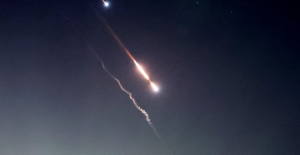As with several migration movements from other regions of the world, the Federal Republic of Germany is also the country for Ukrainians seeking protection to which they most often move on after fleeing their home country. Apart from the direct neighboring country of Poland – which has a 520-kilometer-long land border with Ukraine – Germany has taken in by far the most refugees from the Ukraine invaded by Russia in Europe.
According to the United Nations Refugee Agency (UNHCR), 1.47 million people seeking protection are registered in Poland, and around 1.01 million live in Germany. This is followed at some distance by the Czech Republic (456,000), Italy (172,000), Spain (150,000), Great Britain (140,000) and France 119,000. In addition, around 2.85 million Ukrainians are said to have fled to Russia from the acts of war caused by Moscow; however, many of them may have returned or moved on to other countries.
Like all other available figures for the Ukraine refugees, the UN figures mentioned are only to be understood as an approximate approximation of reality. As before, many onward journeys or returnees as well as unregistered new arrivals can be assumed.
The fact that it is geographically closer to Ukraine than most other European countries and is the most populous and economically strongest country in Europe plays a role in the strong immigration to Germany. Although the UNHCR does not provide per capita admission rates, it should also be noted that, according to figures published by the OECD Migration Department at the beginning of October, in addition to the most important host country, Poland, some smaller EU countries are also more affected by the flight to Ukraine in terms of their population than Germany.
While there are around twelve Ukrainians per 1,000 inhabitants in the Federal Republic, there are more than 40 in the Czech Republic and Estonia, 37 in Poland, more than 20 in Latvia and Lithuania and around 17 in Slovakia. Only after these Eastern European countries does Germany follow, if based on population size.
In contrast to these states, which are currently particularly challenged in the context of the Ukraine flight, the Federal Republic is at the same time affected by a large number of asylum seekers from other regions of the world. The asylum seekers, who mostly move illegally via Turkey or North Africa to Greece, Italy and Spain, sooner or later migrate further north from there – most often to Germany.
This year again, by far the largest number of first-time asylum applications were recorded in this country in Europe. According to the Federal Office for Migration and Refugees (BAMF), by the end of September there were around 135,000 in the current year, a good third more than in the same period last year. As in previous years, the main countries of origin in 2022 are Syria, Afghanistan, Turkey and Iraq.
It is noteworthy that the overall protection rate – i.e. the proportion of asylum seekers who receive refugee, subsidiary or deportation protection from the BAMF – has risen to 56 percent. In recent years, usually only about a third of the applicants have been recognized. The record high is also due to the fact that decisions are now being taken on many applications from Syrians who had been recognized as refugees in Greece in recent years - but then moved to Germany to submit new applications. These cases have been postponed for a long time and are now being processed bit by bit; they almost always end in recognition.
Another reason for the unusually high recognition rate is that the Afghans who have been immigrating to Germany in large numbers for a decade have mostly been recognized since the Taliban took power; previously this was only roughly the case for every second person. The vast majority of Iraqis and Turks will not receive a protective title this year either; however, even rejected applicants are only brought back to their homeland in very small numbers.
In addition, the last federal governments have increasingly created regulations that not only grant asylum seekers, once recognized, temporary protection until the end of the respective war or the persecution situation, but also a permanent right to stay together with a relatively quick right to naturalization. The current government wants to further accelerate this.
The Federal Police had informed WELT AM SONNTAG that the number of “unauthorized entries into Germany detected” has increased noticeably since June 2022 “outside of the statistical and seasonal fluctuations”. According to this, 12,701 entries were recorded in September. That was almost 50 percent more than in August and almost twice as many as in the summer months of June and July.
"Kick-off Politics" is WELT's daily news podcast. The most important topic analyzed by WELT editors and the dates of the day. Subscribe to the podcast on Spotify, Apple Podcasts, Amazon Music, among others, or directly via RSS feed.

 Torrential rains in Dubai: “The event is so intense that we cannot find analogues in our databases”
Torrential rains in Dubai: “The event is so intense that we cannot find analogues in our databases” Rishi Sunak wants a tobacco-free UK
Rishi Sunak wants a tobacco-free UK In Africa, the number of millionaires will boom over the next ten years
In Africa, the number of millionaires will boom over the next ten years Iran's attack on Israel: these false, misleading images spreading on social networks
Iran's attack on Israel: these false, misleading images spreading on social networks New generation mosquito nets prove much more effective against malaria
New generation mosquito nets prove much more effective against malaria Covid-19: everything you need to know about the new vaccination campaign which is starting
Covid-19: everything you need to know about the new vaccination campaign which is starting The best laptops of the moment boast artificial intelligence
The best laptops of the moment boast artificial intelligence Amazon invests 700 million in robotizing its warehouses in Europe
Amazon invests 700 million in robotizing its warehouses in Europe Switch or signaling breakdown, operating incident or catenaries... Do you speak the language of RATP and SNCF?
Switch or signaling breakdown, operating incident or catenaries... Do you speak the language of RATP and SNCF? Transport in Île-de-France: operators are pulling out all the stops on passenger information before the Olympics
Transport in Île-de-France: operators are pulling out all the stops on passenger information before the Olympics Radio audiences: France Inter remains firmly in the lead, Europe 1 continues its rise
Radio audiences: France Inter remains firmly in the lead, Europe 1 continues its rise Russian cyberattacks pose a global “threat”, Google warns
Russian cyberattacks pose a global “threat”, Google warns A new Lennon-McCartney duo, more than 50 years after the Beatles split
A new Lennon-McCartney duo, more than 50 years after the Beatles split The Curse vs Immaculée: two thrillers but only one plot
The Curse vs Immaculée: two thrillers but only one plot Mathieu Kassovitz adapts The Beast is Dead!, the comic book about the Second World War and the Occupation by Calvo
Mathieu Kassovitz adapts The Beast is Dead!, the comic book about the Second World War and the Occupation by Calvo Goldorak 'has never lived so much as now'
Goldorak 'has never lived so much as now' Skoda Kodiaq 2024: a 'beast' plug-in hybrid SUV
Skoda Kodiaq 2024: a 'beast' plug-in hybrid SUV Tesla launches a new Model Y with 600 km of autonomy at a "more accessible price"
Tesla launches a new Model Y with 600 km of autonomy at a "more accessible price" The 10 best-selling cars in March 2024 in Spain: sales fall due to Easter
The 10 best-selling cars in March 2024 in Spain: sales fall due to Easter A private jet company buys more than 100 flying cars
A private jet company buys more than 100 flying cars This is how housing prices have changed in Spain in the last decade
This is how housing prices have changed in Spain in the last decade The home mortgage firm drops 10% in January and interest soars to 3.46%
The home mortgage firm drops 10% in January and interest soars to 3.46% The jewel of the Rocío de Nagüeles urbanization: a dream villa in Marbella
The jewel of the Rocío de Nagüeles urbanization: a dream villa in Marbella Rental prices grow by 7.3% in February: where does it go up and where does it go down?
Rental prices grow by 7.3% in February: where does it go up and where does it go down? Europeans: the schedule of debates to follow between now and June 9
Europeans: the schedule of debates to follow between now and June 9 Europeans: “In France, there is a left and there is a right,” assures Bellamy
Europeans: “In France, there is a left and there is a right,” assures Bellamy During the night of the economy, the right points out the budgetary flaws of the macronie
During the night of the economy, the right points out the budgetary flaws of the macronie Europeans: Glucksmann denounces “Emmanuel Macron’s failure” in the face of Bardella’s success
Europeans: Glucksmann denounces “Emmanuel Macron’s failure” in the face of Bardella’s success These French cities that will boycott the World Cup in Qatar
These French cities that will boycott the World Cup in Qatar Champions League: semi-final schedule revealed
Champions League: semi-final schedule revealed Serie A: AS Roma extends Daniele De Rossi
Serie A: AS Roma extends Daniele De Rossi Ligue 1: hard blow for Monaco with Golovin’s premature end to the season
Ligue 1: hard blow for Monaco with Golovin’s premature end to the season Paris 2024 Olympics: two French people deprived of the Olympic Games because of a calculation error by the international federation?
Paris 2024 Olympics: two French people deprived of the Olympic Games because of a calculation error by the international federation?


















